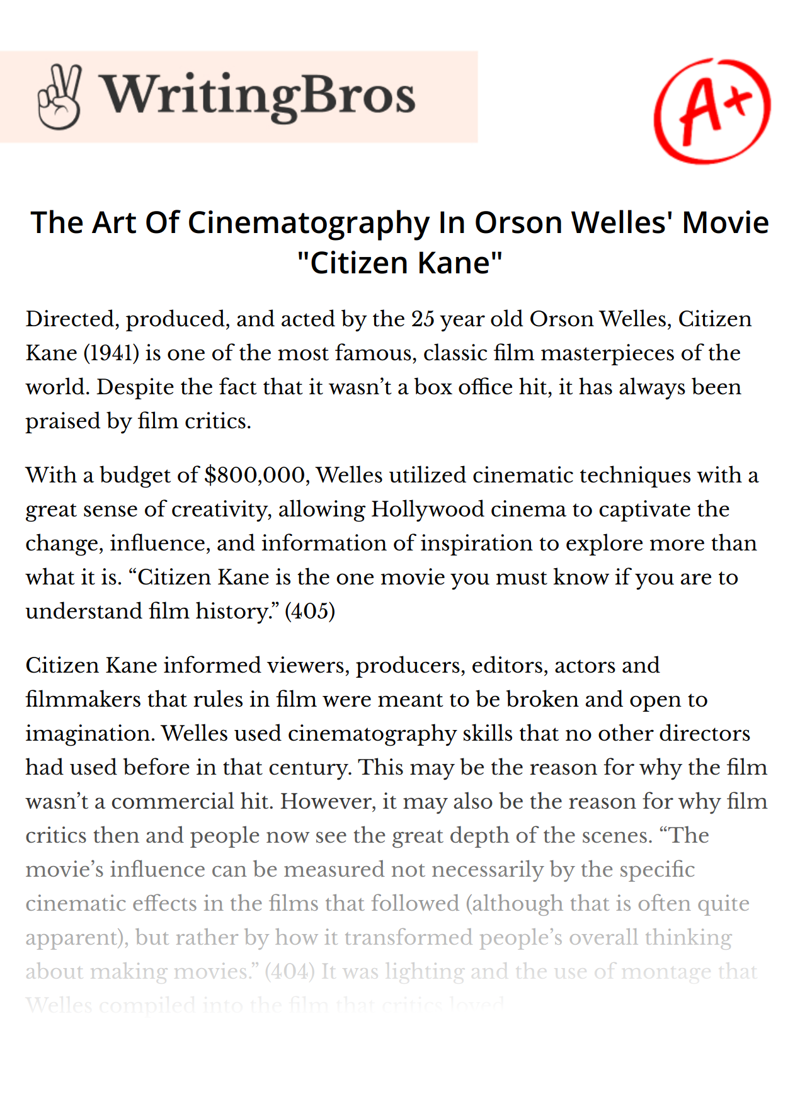The Art Of Cinematography In Orson Welles' Movie "Citizen Kane"

Directed, produced, and acted by the 25 year old Orson Welles, Citizen Kane (1941) is one of the most famous, classic film masterpieces of the world. Despite the fact that it wasn’t a box office hit, it has always been praised by film critics.
With a budget of $800,000, Welles utilized cinematic techniques with a great sense of creativity, allowing Hollywood cinema to captivate the change, influence, and information of inspiration to explore more than what it is. “Citizen Kane is the one movie you must know if you are to understand film history.” (405)
Citizen Kane informed viewers, producers, editors, actors and filmmakers that rules in film were meant to be broken and open to imagination. Welles used cinematography skills that no other directors had used before in that century. This may be the reason for why the film wasn’t a commercial hit. However, it may also be the reason for why film critics then and people now see the great depth of the scenes. “The movie’s influence can be measured not necessarily by the specific cinematic effects in the films that followed (although that is often quite apparent), but rather by how it transformed people’s overall thinking about making movies.” (404) It was lighting and the use of montage that Welles compiled into the film that critics loved.
Montage, “the cinematic technique used to provide a bunch of information in a short time/show the passing of time.” The shot of montage came with the help of the editor, Robert Wise and director of photography, Greg Toland. The famous montage scene is established in the breakfast scene between Kane and Emily. Kane and Emily sit on polar opposite sides of long tables; quite, of passing through time. Revealing the status of their relationship as time passes through the montage, days go by, with the change of clothes and pans; the viewers witness the distance between the two, creating an illustration of visionary.
Citizen Kane broke all the rules. It introduced innovate, narrative storytelling, and cinematography techniques. “Welles also wanted depth in his sets, and so he used deep-focus cinematography to capture a pictorial depth that effectively allowed actors to move around the set whenever and however they wanted.” (405). A deep focus shot “probes space and explores the uniquely cinematic intersection of space, time, and movement.” It is seen in the sequence of Susan Alexander Kane (Dorothy Comingore) trying to kill herself that the use of deep focus is well used. The foreground, middle ground and background are all in sharp focus and doesn’t really have a clear view for the viewers to interpret which then enables them to look closer at the segments. Welles use of deep focus is not like the standard Hollywood cinematic way of technique.
While Welles followed his own way of narration in his film, improvising on different techniques, he also followed his own way of storytelling in a nonlinear structure. Presenting with numerous flashbacks of Kane’s death and then backwards to his fame and childhood. Welles presented his elements of mise-en-scene to reinforce a sense of the recurring theme of ‘loss’ in Kane’s life. From the beginning, Kane appears to be longing for his childhood, as he grasps for “Rosebud.” Towards the end of the film, Kane eventually has a loss in his marriage with Emily, with his newspaper, his close friend, Leland, and of his election of Governor of New York. The theme of loneliness and the camera editing of Kane during his last hours are important enough to understand the setting and emotions of Kane’s life: poor, unworthy, lonely, and dark.
Through Kane’s use of unique methods of creating narration, he greatly inspired others on how films were shot. Whether it was the lighting, angles, deep-focus, shadows, or blocking shots. Citizen Kane is a narration about absolute power corrupting. Made in the 40s, yet still a masterpiece, then and now.
Although Welles wasn’t understood at the time of his film release, he is now, and is greatly known for his impact on the film industry. Today, many films are released for the social marketing scale. Modern day films are filled with bright “color, widescreen, 3-D, fast-paced action, violence, and sex.” (405) However, it is the innovations of an editor and its skills, a cameraman and its framework, an actor and their voice, or a director and their use of narration in a film that keeps cinema alive and creative.
Cite this Essay
To export a reference to this article please select a referencing style below

